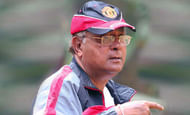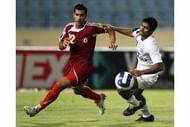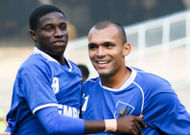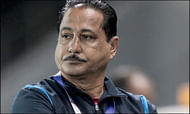The national team might have failed to qualify for the 2014 AFC Challenge Cup, but it’s not all doom and gloom for India on the continental stage, as both their representatives in the 2013 AFC Cup, a tournament which is the equivalent of the Europa League in Asia, have excelled.
East Bengal, who qualified for the tournament after winning the Federation Cup, have been the most impressive with seven points from their three matches. They lead the standings in Group H, and with two of their last three matches at home, the Red-and-Gold brigade have a great chance of not only reaching the knockout stage for the first time since 2004, but also progressing as group winners, which would give them home advantage in the one-legged round of 16 tie.
Churchill Brothers only entered the competition following the withdrawal of I-League holders Dempo. With East Bengal having already qualified through their Federation Cup triumph, Churchill got a slot because of their third place finish in the I-League. The Goan club have had to play their home matches in Pune due to the unavailability of their ground in Goa, but have still managed to pick up four points from three games. Churchill may not be in a great position, but are still very much in contention to reach the round of 16, like they did in 2010, their only previous appearance in the AFC Cup.
India have had two representatives ever since the AFC Cup started in 2004, but never have both clubs made it past the group stage. So the 2013 edition could witness history if East Bengal can win one more match and Churchill can raise their game to win two out of their remaining three fixtures.
The performance of Indian clubs in the continental competition has been poor in recent seasons, mainly because they have been drawn with clubs from West Asia, while some teams just haven’t had the strength in depth to be competitive in both the I-League and AFC Cup. This season, both East Bengal and Churchill Brothers were kept in groups having clubs from South-East Asia and the results are there for everyone to see.
Sportskeeda looks back at Indian clubs’ showings in the previous nine editions and rates the overall performances of each year.
2004 (League champions: East Bengal; Cup winners: Mahindra United)
Having won the ASEAN Cup in 2003, much was expected from Subhash Bhowmick’s East Bengal side in the inaugural edition and they didn’t disappoint. The Kolkata club topped their group with 13 points from six games, scoring 14 goals, but were up against Syria’s Al Jaish in the quarter-finals. The Kolkata club were wasteful in the first leg, drawing goalless and then were beaten 3-0 in the second leg in Syria. Al Jaish went on to win the trophy, which just showed how big a task East Bengal faced in the quarters. The other representative, Mahindra United, crashed out from the group stage but still managed four points in a three-team group which had Syria’s Al Wahda and Oman’s Dhofar Club. Mahindra were unbeaten in their two home matches but lost both of their away fixtures.
Rating: 3/5
2005 (League champions: East Bengal; Cup winners: Dempo)
This edition turned out to be a very disappointing one, as both East Bengal and Dempo crashed out of the group stage. Not much was expected from Dempo in this edition as they were still getting used to Asian competition and were drawn alongside two West Asian teams – Al Hussein (Jordan) & Al Ahed (Lebanon). Dempo lost all four of their games, scoring none and conceding seven. East Bengal were at least expected to go past the group stage but finished third in their group behind Al Faisaly (Jordan) and Nebitci Balkanabat (Turkmenistan). East Bengal managed only seven points, with no wins in their first four matches and just one home victory.
Rating: 1/5
2006 (League champions: Dempo; Cup winners: Mahindra United)
This was another poor showing, as neither team got past the group stage and the two representatives managed just three wins between them in ten matches. With this being their second straight appearance, Dempo were hoping for a better display but they recorded only four points and finished second in a three-team group which was topped by Oman’s Al Nasr. Statistically, Mahindra United did very well as they lost just one match in their group, which had Bahrain’s Al Muharraq, eventual runners-up, and Lebanon’s Al Ahed. Mahindra managed to avoid defeat both in Bahrain and Lebanon, but the 2-2 draw away at Bangladesh’s Brothers Union proved to be the disappointing result as they eventually finished third and crashed out.
Rating: 1.5/5
2007 (League champions: Mahindra United; Cup winners: Mohun Bagan)
Till date this edition remains India’s best in Asia’s Europa League, as both clubs finished second in their group, but only one of them made it through to the next round, as back then the top two teams of each group were not guaranteed a spot in the knockout stage. Just like the 2013 edition, both Mahindra United and Mohun Bagan were drawn alongside South-East Asian clubs and that certainly suited the two Indian teams. Mahindra registered four wins and finished second behind Singapore Armed Forces FC (now Warriors FC) while Mohun Bagan were runners-up of their group behind another Singapore club, Tampines Rovers. The green-and-maroon brigade scored only five goals, but conceded only three with four clean sheets in total. Ironically, it was Mahindra United who edged out Mohun Bagan as the best second-placed team and progressed to the last eight. Mahindra faced Lebanon’s Al Nejmeh in the quarters and despite losing the first leg 2-1 at home, the Mumbai club were on the verge of the semi-finals as they were leading 3-2 in Lebanon until a stoppage time equaliser broke their hearts.
Rating: 4.5/5
2008 (League champions: Dempo; Cup winners: East Bengal)
Mahindra were minutes away from becoming the first Indian club reach to the last four of the AFC Cup in 2007 and a year later Dempo actually achieved that. The Goan club were simply outstanding in the group stage as they finished second in a group that had three West Asian teams including Bahrain’s Al Muharraq, who went on to win the tournament. Dempo incredibly defeated Muharraq in Bahrain and finished with eleven points, and then in the quarters played some attractive football to beat Singapore’s Home United 5-4 on aggregate. Dempo made history by reaching the semis but the two-legged tie against Lebanon’s Safa proved to be too big a hurdle as they were thumped 5-1 over two legs. East Bengal might have failed to get past the group stage, but they recorded some memorable results like the 2-0 win away at Jordan’s Al Wehdat and a goalless draw at home against Safa.
Rating: 4/5
2009 (League champions: Dempo; Cup winners: Mohun Bagan)
This edition marked the start of India’s downward spiral in this competition, as for the first-time ever, one team lost each of their group games. That unwanted feat was recorded by Mohun Bagan, who were unfortunate to be drawn alongside three West Asian clubs but showed very little resistance even in the home matches. The green-and-maroon brigade scored just one goal and conceded 19 in an embarrassing showing under Karim Bencherifa. Dempo saved some of the blushes by finishing second in a group that also had three clubs from the Gulf region. Armando Colaco’s side did remarkably well to finish second ahead of two former champions Al Muharraq (Bahrain) and Al Faisaly (Jordan).In the one-off round of 16 clash Dempo lost 3-1 at Al Kuwait, who later went on to win the competition.
Rating: 3/5
2010 (League champions: Churchill Brothers; Cup winners: East Bengal)
East Bengal matched their arch-rivals’ feat by losing all six of their matches in this edition. The Kolkata club were struggling in the I-League and thus didn’t have the resources to do well in the continent and a group comprising of three other West Asian teams made it even more difficult. Coached by Belgian Phillipe De Ridder, East Bengal conceded 20 goals in six straight defeats. Once again it was a Goan club who restored some pride for India but Churchill Brothers were a bit lucky as they only had to finish second in a three-team group. As they finished runners-up in their group, Churchill didn’t have home advantage in the round of 16 tie and lost to Kuwait’s Al Qadsia 2-1.
Rating: 2/5
2011 (League champions: Dempo; Cup winners: East Bengal)
Trevor Morgan’s first AFC Cup campaign as East Bengal coach failed to bring any win in the group stage as his side could only manage three draws. For East Bengal, there was no excuse of having West Asian teams as all their group opponents were from the ASEAN region. But unlike 2013, Morgan didn’t have the strength in depth back then to impress at Asian level and thus finished bottom of the group. Dempo too weren’t that great as they managed just two wins in six matches but two of their group opponents were from West Asia while they also had Uzbekistan’s Nasaf Qarshi, who put 13 past the Indian club over two matches and went on to win the competition. In the round of 16 clash, Dempo fought hard but narrowly went down 1-0 to Iraq’s Duhok.
Rating: 2.5/5
2012 (League champions & Cup winners: Salgaocar; Cup runners-up: East Bengal)
This would go down as the worst edition for Indian clubs, as the two representatives managed only 4 points in 12 matches. All four of those points were recorded by Karim Bencherifa’s Salgaocar, but that couldn’t prevent a rock-bottom finish. East Bengal repeated their 2010 showing by losing all six matches, scoring two and conceding fourteen. The Kolkata club, unlike Salgaocar, had their eyes on the I-League title race and with all of their group opponents being from West Asia, the gulf in class was just too much. For the first time since 2006, no Indian club could progress to the knockout stage.
Rating: 0.5/5





